|
Cold War Warriors My Prague adventure in the summer of 1962
Ludwig Pilato
(9/2012) In late August, 1962, I was attending university in Munich, Germany, and a group of friends and I seized the opportunity to join a bus excursion to Prague, Czechoslovakia. We had just a few days left of summer vacation.
When we were at the border leaving West Germany, the West German customs police barely looked at our passports, and just waved us ahead with a smirk. After all, who would want to leave West Germany for Czechoslovakia in 1962? After crossing "no man’s land", we had to get off the bus and line up in single file to enter a drab, crumbling Czech building,
where we were herded single file down a hall made of six foot high chicken wire fencing leading to a frowning customs officer. Our luggage was searched and passports examined.
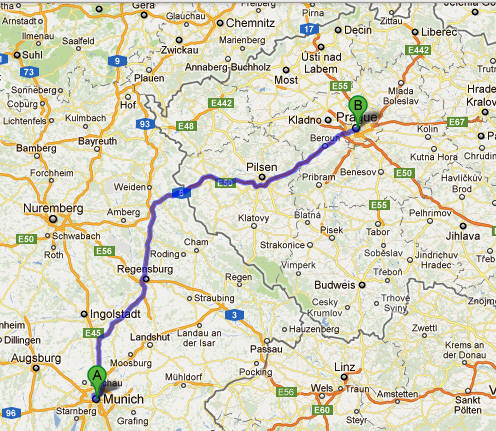
(Munich to Prague) - Route followed by tour bus from Munich to Prague and the People’s Paradise.
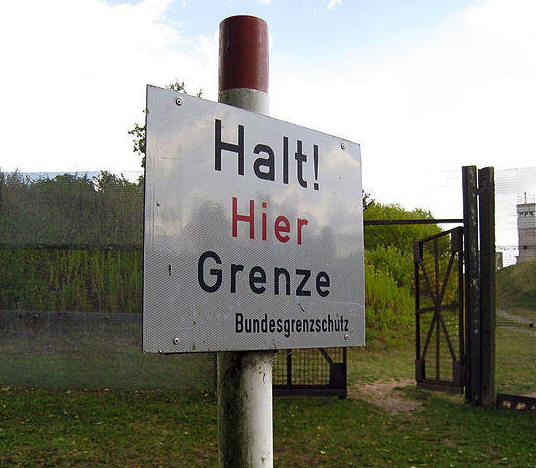
German Border Warning – "HALT – Boundary Limit. Stop here". Go any further and you are in a "People’s Paradise" called East Germany, Hungary, Poland, Czechoslovakia. You are not in Deutschland anymore. Signs such as this were posted all along the Iron Curtain.
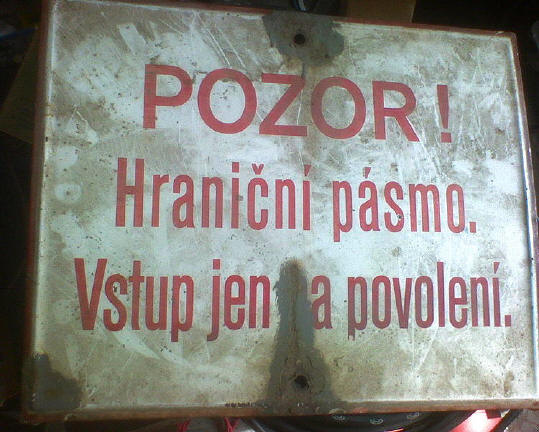
Czech Republish Border Warning – " ATTENTION. Border Zone. Entrance Only Allowed" Translated – enter at your own risk into the People’s Free Republic of Czechoslovakia. Have a nice day!
After a wait of about an hour, it was announced that we had to present current shot records, or receive free inoculations before we could enter Czechoslovakia. In planning this trip, following the travel agency instructions, we obtained all required documentation, but apparently none of the busy travel arrangers mentioned the need for shot records. No
one knew we needed shot records. This news struck panic in the group, having heard of questionable medical practices and medications in the east. A medical student among us protested and started quoting the differences in serums used in the east and west at the time. After much back and forth, our group decided to return to West Germany, get the demanded shots and return with
updated shot records. The Czech customs official gave his approval for this resolution.
After a lot of explaining, phone calls by the West German officials, detailed examination of all luggage and thorough review of our travel documents, we were re-admitted to West Germany. Fortunately, with our "good connections" with the U.S. military and other authorities, we obtained our injections and documentation, and returned to the border the
next day, where we promptly were allowed to cross into Czechoslovakia.
As we boarded the bus, Czech officials warned us sternly not to leave the bus at any time, and absolutely no photographs were allowed to be taken from the bus. We were assigned a tour guide, and told that the bus could not go anywhere without the tour guide on board. This "tour guide," who did not even pretend to be a tour guide, was a sullen fellow in
a black trench coat despite the summer weather. He sat in the front seat next to the bus driver and never uttered a word. He simply turned around to look at the passengers every few minutes. This guide, as we all knew, would be our shadow for the duration of our trip, hopefully not with a Kalashnikov under his coat.
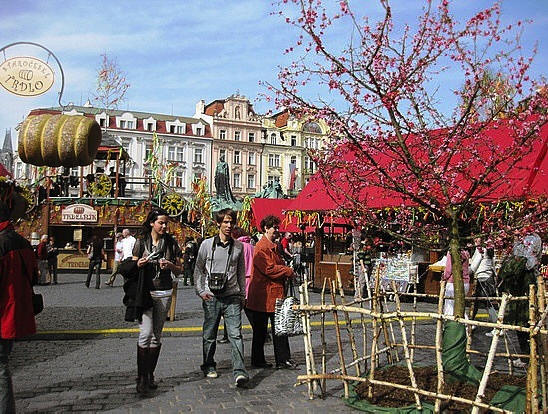
Prague Czechoslovakia – "Old Place" (Staro Mesto) during summer festival. The gathering spot for European University students. on Spring and Summer break. Even under Communism.
Before letting us loose in Prague, hotel staff informed us to enjoy free Czechoslovakia, and to tell our friends at home how wonderful Prague is. Prague was, and is, a magnificent city. The inhabitants, however, were not so enthusiastic. Everything seemed to proceed in slow motion, and everyone appeared to be dressed in gray. Though we stayed in a
grand old hotel, the splendor was faded. Many light bulbs were bare, and wallpaper peeled from the walls. The elevators did not work. The plumbing was loud and the water questionable. Only the front desk had telephones.
When we were walking in a group sightseeing on the streets of Prague, we immediately noticed our tour guide following us, making no attempt to go unnoticed. No matter where we were, we could find his frowning face somewhere in the crowd.
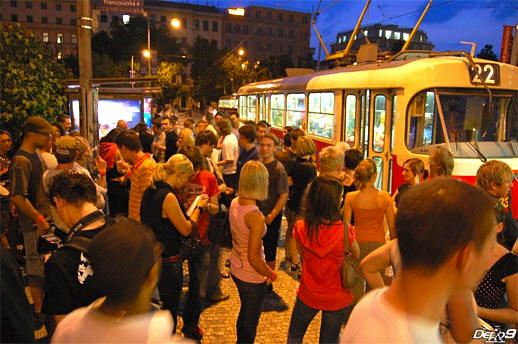
Prague nightclub scene – Today! Doubt Ludwig’s scene was like this.
Today they have a Tram that takes you from one club to another.
One evening, we went to a night club which was advertised as "world class" in the hotel pamphlet. It was a comfortable jazz club, albeit filled with a thick fog of cigarette smoke, with exceptionally good jazz played by talented musicians. Although the imitation Louis Armstrong singing was somewhat " over the top!" At one point our group noticed that a
number of patrons were giving our group a wide berth, and a kind, young Czech fellow, who identified himself as a student, felt it necessary to explain to us that some of the others in the club were scared of one of the female members in our group, because she had the look of a witch. Apparently the ample green eye makeup worn by our companion was unknown in Prague, and
aroused Czech superstition. After she wiped her eyes with a napkin to remove the makeup, the worried patrons smiled sheepishly.
On the streets of Prague, we always saw groups of young Russian soldiers walking around, apparently on leave and being tourists as we were. The soldiers all looked like - very strong, stocky farm boys in uniforms with high boots. What struck us was their clothing. In that summer sun, they wore their only issued uniforms which were heavy winter woolens.
Noticeably perspiring, they smelled rather badly when passing us by on the street.
On our return to West Germany on the bus, we were again accompanied by our sullen tour guide. The Czech roads at the time were all two lanes, apparently with no autobahn equivalents. At one point, somewhere between Prague and Karlovy Vary, the road we were using paralleled multiple railroad tracks, with vast numbers of railway flat cars. The tour guide
stood up in the bus and yelled in bad German, Keine Bilder, Keine Bilder! meaning "no photos".
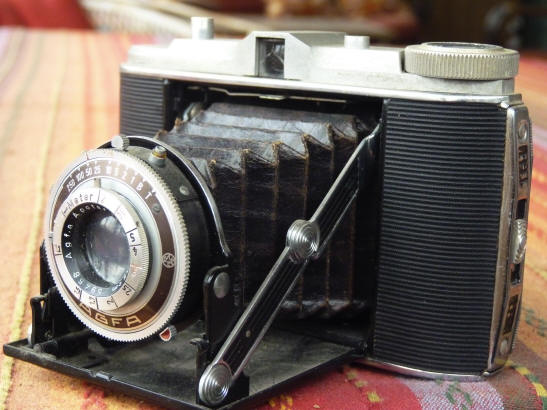
PHOTO 8 – AGFA camera – Ludwig’s trusty 33mm folding camera that made its own little bit of Cold War history. Manufactured in Munich by Agfa Kamerawerk AG, in the 1950s.
I had my trusty Agfa Isolette camera in my bag on my lap, and what young fool could resist such a challenge? Behind the cover of the seat in front of me, I opened my camera, and by raising the camera lens just an inch over the window sill of the bus, I clicked away taking pictures, with my body facing forwards, so that our tour guide had no clue what I
was up to. The old Agfa had a loud shutter, but the diesel bus was so loud, slowly rumbling down the road, that even I could barely hear the shutter.
The Agfa was also not easy to operate, but I was very familiar with it. In a quick moment, I adjusted the shutter and exposure settings - each frame required loading the shutter spring - while also advancing each frame with a rotary knob. The narrow roll of film had a maximum capacity of 12 frames, and there on the bus, I exposed the remaining
unexposed eight frames still in the camera. Some of the resulting photos were a little fuzzy, but not bad, considering the conditions. I was photographing an incredible array of Russian military equipment – tanks, trucks, half tracks, rockets, howitzers, cranes, bull dozers, motorcycles, and strange long metallic tubes filled with what not even my imagination could guess – as
it rumbled slowly along on a convoy of rail flatcars.
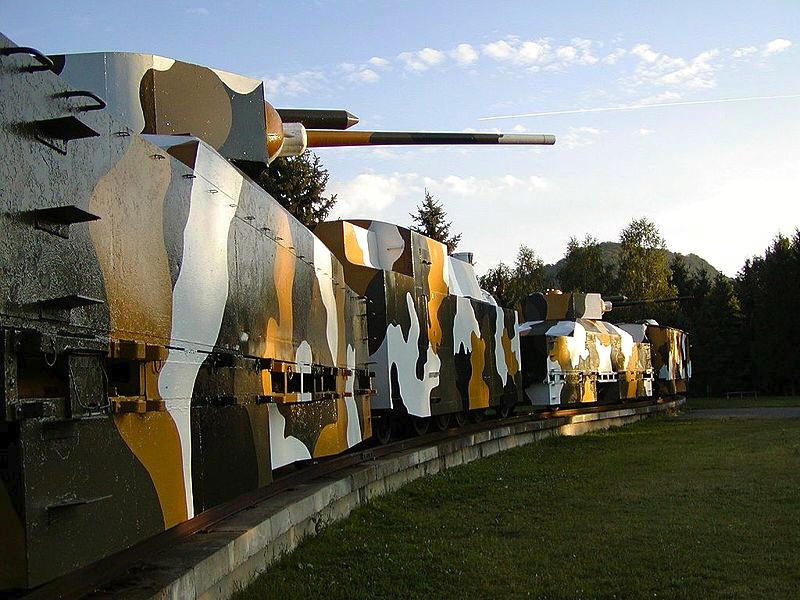
Soviet military train – Soviet military equipment being moved by train through Eastern Europe … in the 1980s. Twenty years late, but Ludwig’s photos were probably just as good?
A day after safely returning to Munich, I went to a former German Reich’s SS Kaserne (Barracks), now occupied by the U.S. Army and called McGraw Kaserne. I sat in the snack bar filled with American soldiers and civilians eating hamburgers, and drinking 10-cent bottles of Bavarian beer. I had met a group of friends there, and we talked openly without
concern about the trip to Prague. I bragged about taking secret pictures of Russian armaments.
The next morning at about 6:00, as I was just waking but still in bed, I heard loud knocking on the door to my room, and a voice demanded that I open the door immediately. I was confronted by two men in black leather jackets, wearing dark two-day beards, and a clean-cut young man in civilian clothes, who flashed his ID card and identified himself as a
lieutenant in the United States Army. Speaking for the group, the lieutenant told me that the he was requesting my camera with photos of my recent trip to Czechoslovakia. He told me that my property would be returned to me promptly. Without question, I gave him my camera. He gave me a receipt, and told me not to leave the city until informed otherwise.
The following day I was visited again by these men. The lieutenant smiled slightly, so I felt relieved that they would likely not throw me in jail, and asked me politely to come with them. They took me to an apartment on McGraw Kaserne, and told me they had an interest in my photographs. They produced large maps of Czechoslovakia, and asked me to trace
the route our trip had taken. In what I took to be Czech accents, the two men in black leather jackets quickly identified the railroad tracks and rail yards which I had photographed. We established time lines, and they returned my camera, negatives, and prints to me. They scolded me for taking the photos, and told me I could have ended up in jail over there. I believed them.
In a way this little incident was comforting at the time, because it demonstrated that the western intelligence network was working very well, and was protecting us.
The next day my friends and I joked that this was a cool way to get my prints developed for free. I of course did not know where that mass of Russian war machinery was headed at the time, but the Cuban Missile Crisis was only a month and a half in our future.
Lou Pilato is a native of Bremen-Vegesack, Germany. He was a university student in Munich Germany at the time of this incident. He emigrated to the U.S. and has a graduate degree from the University of Maryland, Baltimore. He has worked extensively in the field of information resource management and is currently working in the field of mental
health.
Editor’s Note - In 1962 the Soviets were moving SS20 IRBM (intermediate range ballistic) missiles into East Germany, Czechoslovakia, and Cuba. Partly in response to the U.S. deployment of Pershing missiles into Turkey. It was the peak of the Cold War when the U.S. and USSR were edging ever closer to all-out nuclear warfare. To a young, German
university student it was time for summer vacation in one of Europe’s student meccas - even under Communism. Prague in the Spring or Summer was THE place! Except when the Soviet Tanks came rolling in during Spring break of 1968. Prague Spring 1968 was NOT a fun time to be in the People’s Paradise.
Read other Cold War Warrior
Articles
|